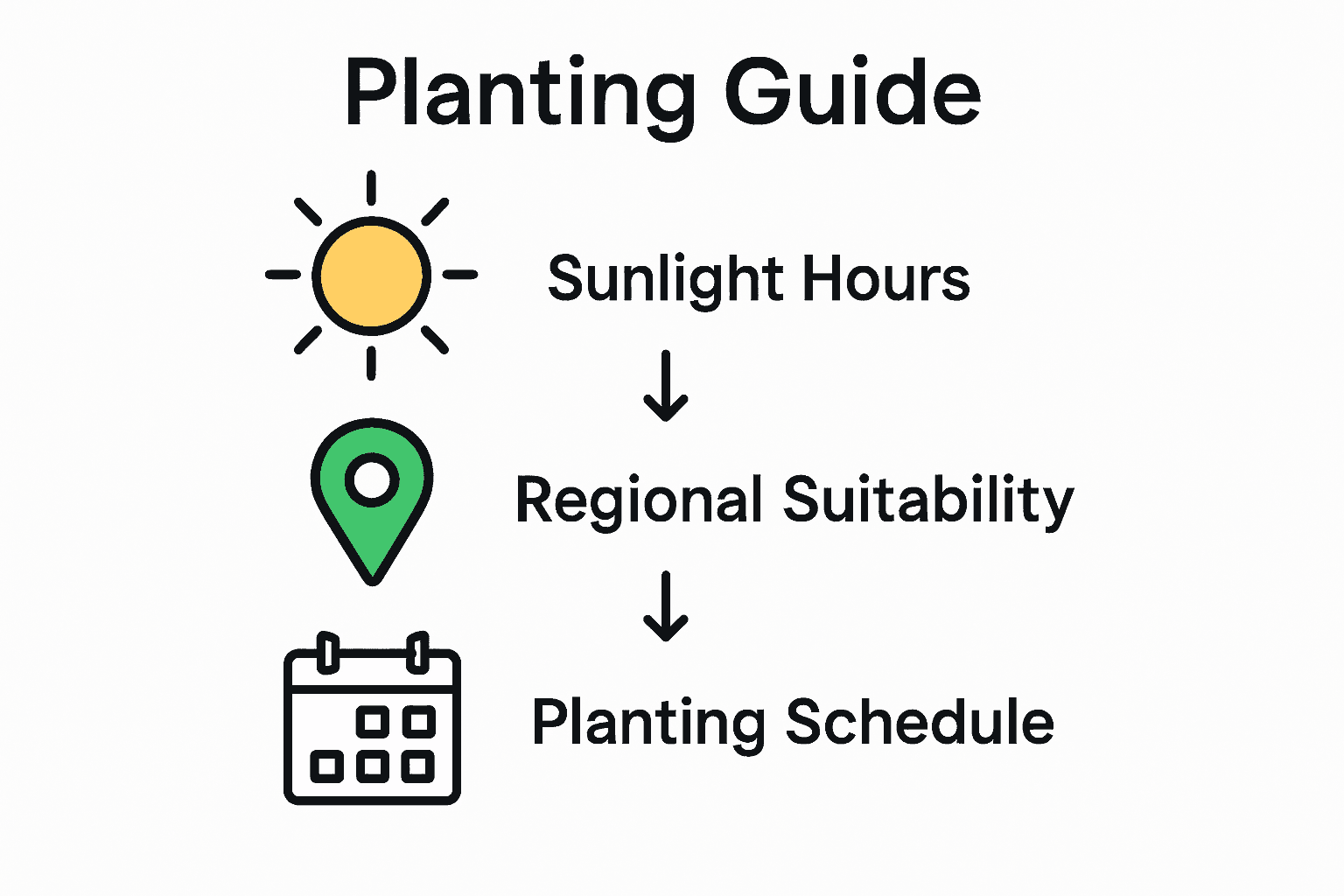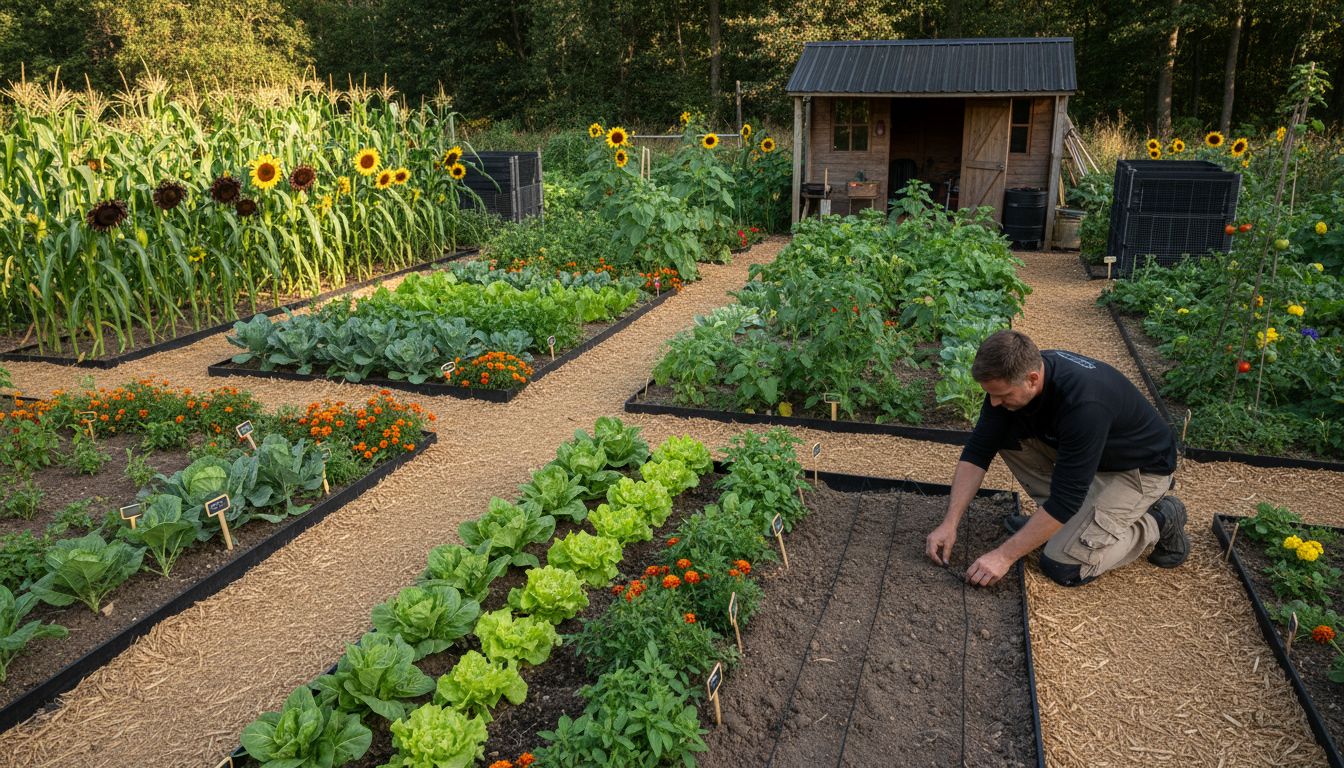Table of Contents
Nearly 35 percent of new gardeners give up within the first year, often because they miss a few basic steps. Setting up a successful vegetable garden starts long before seeds hit the soil. From picking the sunniest spot in your yard to choosing plants that truly thrive in your climate, careful planning can make all the difference between a fruitful harvest and frustration. Discover how a few proven methods can turn your garden dreams into a rewarding reality.
Quick Summary
| Key Point | Explanation |
|---|---|
| 1. Choose a sunny location | Select a garden area with at least six hours of direct sunlight daily for optimal growth. |
| 2. Select region-appropriate vegetables | Understand your climate and growing season to choose vegetables that thrive in your area. |
| 3. Plan a strategic garden layout | Design the garden by grouping plants for sunlight and accessibility to maximize growth and maintenance ease. |
| 4. Prepare soil properly | Test soil pH and nutrients, and amend as needed to create a suitable growing environment for your plants. |
| **5. Create a clear planting schedule |
 ** | Develop a detailed schedule for planting and maintenance tasks, including watering and harvesting routines. |
** | Develop a detailed schedule for planting and maintenance tasks, including watering and harvesting routines. |
Step 1: Assess Your Garden Space and Sunlight
Successful vegetable gardening starts with selecting the perfect growing location. In this critical first step, you will determine the ideal site that provides optimal sunlight and growing conditions for your future vegetable garden.
According to extension.iastate.edu, the most crucial factor is selecting a garden site that receives at least six hours of direct sunlight daily. Avoid shaded areas near buildings or large trees, particularly on the southern exposure. Walk your potential garden space and observe sunlight patterns throughout the day to understand exactly how much direct light each area receives.
A level and well-drained location near a water source will make garden maintenance significantly easier. Consider these key factors when assessing your garden space:
- Total available sunlight hours
- Ground drainage capabilities
- Proximity to water source
- Protection from strong winds
- Accessibility for regular maintenance
As recommended by fieldreport.caes.uga.edu, aim for a minimum of six to eight hours of direct sunlight per day. Observe how sunlight moves across your potential garden location during different times of the day and across different seasons to ensure consistent light exposure.
Once you have identified the perfect spot with adequate sunlight and good growing conditions, you are ready to move on to the next step of garden planning.
Step 2: Select Suitable Vegetables for Your Region
Choosing the right vegetables is crucial for a successful garden. This step will help you select crops that will thrive in your specific local conditions and maximize your gardening success.
According to extension.umd.edu, selecting vegetables well-suited to your local climate and growing season is fundamental. Start by understanding your region’s key characteristics such as temperature ranges, frost dates, and overall growing season length. These factors will significantly influence which vegetables will perform best in your garden.
Understanding vegetable gardening for beginners can help you navigate this selection process. As recommended by njaes.rutgers.edu, consider your specific local conditions including soil type, typical rainfall, and temperature variations. Local extension services are excellent resources for getting precise recommendations for vegetable varieties that will flourish in your area.
Key considerations for vegetable selection include:
- Local temperature and climate patterns
- Length of growing season
- Typical first and last frost dates
- Soil composition and drainage
- Available sunlight in your garden space
Take time to research and consult local gardening experts. Each region has unique growing conditions that can make certain vegetable varieties more successful than others. By carefully selecting vegetables suited to your specific environment, you set yourself up for a more productive and rewarding gardening experience.
Step 3: Design an Efficient Garden Layout
Creating a well-planned garden layout is essential for maximizing your vegetable growing potential. In this step, you will learn how to design a garden space that promotes healthy plant growth and makes maintenance a breeze.
According to extension.umd.edu, strategic garden planning involves grouping plants based on their growth habits and seasonal requirements. A critical tip is to place taller crops on the north or west sides of your garden to prevent them from casting shadows on shorter plants. This ensures all your vegetables receive adequate sunlight throughout the growing season.
When exploring 4 vegetable garden layouts to maximize your yield, consider the recommendations from njaes.rutgers.edu. Design your garden with efficiency in mind by arranging plants in organized rows or blocks. Allow sufficient space between plants to promote good air circulation and easy access for maintenance.
Key considerations for an efficient garden layout include:
- Sunlight exposure for each plant type
- Height and spread of different vegetables
- Crop rotation potential
- Accessibility for watering and harvesting
- Space for pathways between planting areas
A thoughtful garden layout goes beyond mere aesthetics.
 By carefully planning your vegetable placement, you create an environment that supports robust plant growth and makes gardening more enjoyable and productive. Your next step will involve preparing the soil to support these carefully planned plantings.
By carefully planning your vegetable placement, you create an environment that supports robust plant growth and makes gardening more enjoyable and productive. Your next step will involve preparing the soil to support these carefully planned plantings.
Step 4: Prepare Soil and Gather Essential Tools
Preparing your garden starts with creating the right foundation and collecting the necessary equipment. This step will transform your garden space from an empty plot to a thriving vegetable production zone.
According to extension.unh.edu, the critical first task is to test your soil to determine its pH and nutrient levels. Understanding your soil composition allows you to make precise amendments that will support healthy plant growth. Learning how to prepare garden beds naturally can provide additional insights into creating optimal growing conditions.
Research from njaes.rutgers.edu recommends removing existing weeds and debris before tilling the soil to improve aeration and drainage. Your essential tool collection should include:
- Sturdy garden shovel
- Rake for soil leveling
- Hand trowel for precise planting
- Pruning shears
- Watering can or hose
- Gardening gloves
- Wheelbarrow for moving soil and compost
Pro tip: Invest in high-quality tools that will last multiple growing seasons. Proper maintenance and cleaning after each use will extend their lifespan and make your gardening experience more efficient. With your soil prepared and tools gathered, you are now ready to move on to the exciting process of planting your vegetables.
Step 5: Plan Planting Schedule and Maintenance
Transforming your garden from a blueprint to a thriving vegetable ecosystem requires strategic planning and consistent care. In this critical step, you will create a comprehensive roadmap for successful vegetable cultivation.
According to extension.umd.edu, developing a precise planting schedule depends on understanding the specific growing seasons of your chosen vegetables. Consider critical factors like local frost dates and individual crop maturation times. When diving into gardening for beginners, remember that timing is everything in vegetable production.
Research from njaes.rutgers.edu recommends creating a detailed calendar that outlines both planting dates and ongoing maintenance activities. Your maintenance schedule should include:
- Weekly watering routines
- Bi-weekly pest monitoring
- Monthly soil nutrient checks
- Regular weeding sessions
- Timely harvesting of mature vegetables
Pro tip: Develop a garden journal to track your planting dates, growth progress, and maintenance activities. This record will become an invaluable resource for future gardening seasons, helping you learn from each experience and continuously improve your vegetable growing skills. With your planting and maintenance plan in place, you are now prepared to bring your garden to life.
Take Your Vegetable Garden Plan to the Next Level Today
Planning your vegetable garden can feel overwhelming when managing factors like sunlight needs, soil preparation, and planting schedules. This guide breaks down these challenges into clear steps but turning that knowledge into action is where many gardeners struggle the most. If you want to avoid common pitfalls and grow a thriving garden that truly flourishes, tapping into trusted advice and practical tips makes all the difference.
Discover how you can transform your garden design with expert ideas from Design Ideas – Lushy Gardens. Learn simple yet effective methods to optimize sunlight and space for your vegetables while exploring essential Gardening Tips – Lushy Gardens to keep your plants healthy through every season. Whether you are just starting out or looking to improve your current garden, the resources at Lushy Gardens empower you to cultivate a successful vegetable garden with confidence.
Don’t wait for another planting season to pass by. Visit us now and start creating the garden you’ve always wanted.
Frequently Asked Questions
How do I assess my garden space for vegetable gardening?
To assess your garden space, identify an area that receives at least six hours of direct sunlight daily. Observe the sunlight patterns throughout the day and note the drainage and accessibility of the site to ensure optimal growing conditions.
What vegetables are suitable for my local climate?
Choose vegetables that are well-suited for your climate by considering local temperature ranges, frost dates, and typical growing seasons. Research which crops thrive in your area to maximize your gardening success and plan your crop selection accordingly.
How should I design an efficient layout for my vegetable garden?
Design your vegetable garden layout by grouping plants based on their height and sunlight needs. Position taller plants on the north or west side to avoid shading shorter plants, allowing you to maximize sunlight exposure for all your crops.
What is the best way to prepare my soil for planting vegetables?
The best way to prepare your soil is to test its pH and nutrient levels to make necessary amendments. Remove debris, till the soil for aeration, and incorporate organic matter to create a rich, healthy foundation for your vegetable plants.
How do I create a planting schedule for my vegetable garden?
Create a planting schedule by determining your local frost dates and the maturation times of your selected crops. Develop a calendar outlining when to plant each vegetable and include regular maintenance activities like watering and pest monitoring to ensure healthy growth.
What tools are essential for starting a vegetable garden?
Essential tools for starting a vegetable garden include a sturdy shovel, rake, hand trowel, watering can or hose, and gardening gloves. Collect these tools before beginning your gardening tasks to ensure you can efficiently prepare and maintain your garden.
Recommended
- 4 Vegetable Garden Layouts to Maximize Your Yield – Lushy Gardens
- Understanding Vegetable Gardening for Beginners: Key Concepts – Lushy Gardens
- 7 Essential Raised Bed Gardening Tips for Beginners – Lushy Gardens
I’m Eleanor, a seasoned gardener with over three decades of experience tending to Mother Nature’s creations. Through Lushy Gardens, I aim to share my wealth of knowledge and help fellow plant enthusiasts uncover the wonders of gardening. Let’s dive into this journey together, one leaf at a time.